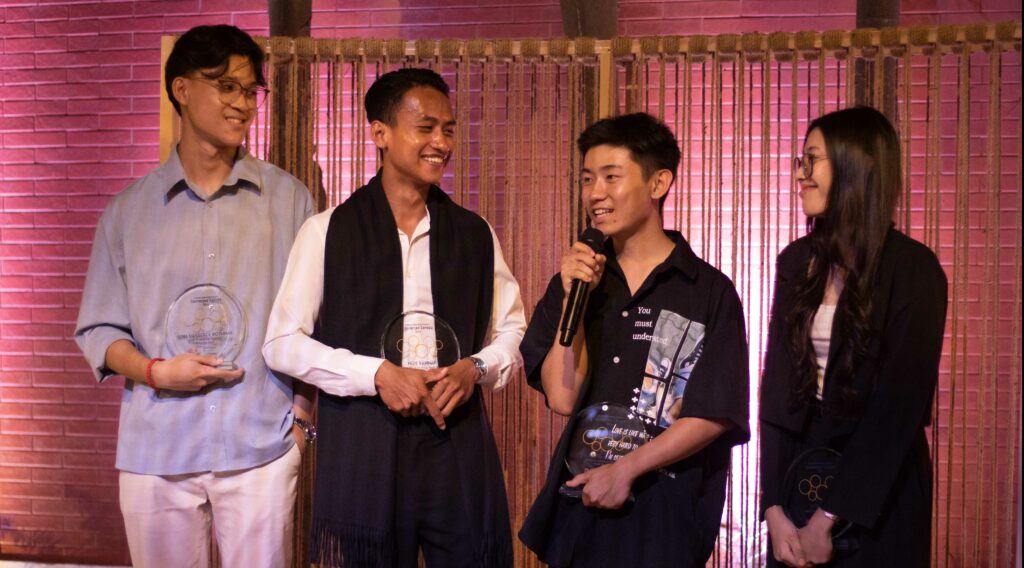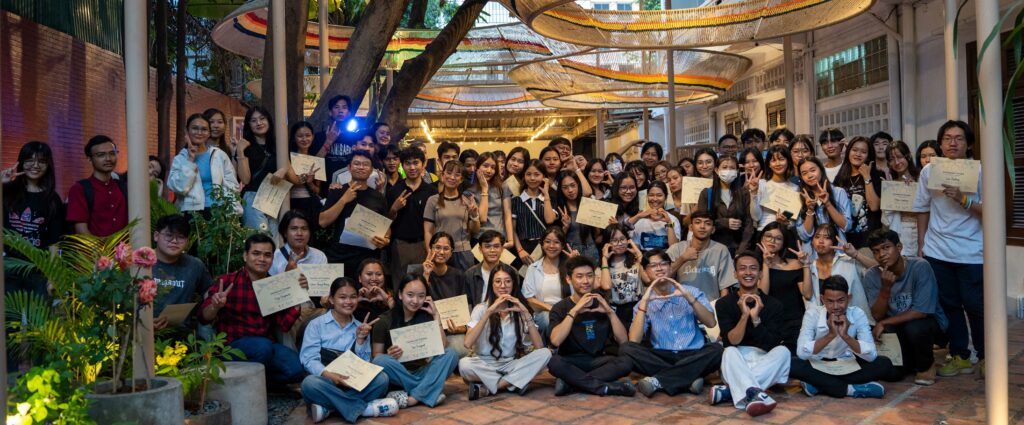
In the heart of Phnom Penh, a new structure rises in the front yard of Cambodian Living Arts. Beyond steel wrapped with locally made colourful Krachao strings, it is a structure woven with vision, collaboration, and community. Connected Canopy is a program created and designed by Creative Generation, produced in collaboration with Cambodian Living Arts. It is more than an architectural innovation; it is a testament to the power of agency in space-making and participatory design from emerging architects, designers and artists.
At our launch event on the 20th of February, Dana Langlois, the founder of Creative Generation, expressed the deep significance of this project. “I think it is really important that the heart of this project is really about community and about people, and that we are able to create spaces by sharing experiences, listening to each other, and then by seeking meaningful connections with one another,” she said.
With a visual arts background and personal interest in community engagement, Dana saw this project as an opportunity to introduce a deeper level of engagement in space-making, the so-called “participatory architecture” which she emphasized is already rooted in the Cambodian way of community-building.
From Vision to Reality
Connected Canopy began as an open canvas, drawing submissions from 16 applicants. Of these, five were selected for their innovative designs and alignment with the project’s vision. The winning team’s project, ”Within the Circle,” was created by its members Som Vanserey Rothnak, Mol Nyta, Cheng Neahav, and Noy Vannak. Their design stood out not just for its aesthetic and functional appeal but also for its engagement with local materials and its environmental consciousness.
Noy Vannak reflected on the project’s significance and on the meaning behind the team’s core concept for the design of the Canopy, which is inspired from Khmer’s ancient “Circular Earthwork,” similar to those found in the Memot district of the Kampong Cham province.

“In the past, our ancestors built using natural materials. As society progressed, we began producing more, sometimes too much. This project is an effort to return to using local materials sustainably, raising awareness about our resources, and improving local economies.”
The collaboration with CLA ensured that the project was not just about constructing a space, but about cultivating a cultural hub. Yon Sokhorn, CLA’s Program Director, emphasized this during the launch. She said that CLA envisioned Connected Canopy to be an “inclusive space,” where artists, performers, and cultural practitioners can gather, create, and share their work.
“We want it to be a meaningful and multifunctional space, accommodating cross-generations of people and cross-artistic disciplines, and where any form of art—whether traditional, modern, or contemporary—can be created for diverse audiences.” Additionally, she said it provides a platform for young creative talents to bring their artistic visions to life.
Learning Through Practice
Connected Canopy is the third edition of The Canopy Project, a concept that Dana Langlois has been refining over time. One of the project’s major goals was to create an opportunity for young designers—not just to design but to build. Students and emerging architects don’t usually get the chance to see their ideas come to life. “This is an opportunity for them to go from start to finish–to fully actualize, to respond to the needs of the project, and to respond to it creatively, then see it through the whole process of production,” Dana explains.
With lessons from past editions, this third version integrated a structured mentorship program, bringing together experts and finalists to refine their designs. The result is a visually striking pavilion—a seamless blend of elegant architectural form and handcrafted artistic elements that reflect Cambodia’s diverse creative community.

“The fact that this work has been meaningful for our team is because it’s highly competitive.” Vannak, a member of the winning team, describes the team’s experience: “The project wasn’t simply handed to us; we had to compete with others from the same architectural field.”
Secondly, it was a “pragmatic experience,” he said. The team had to turn their concept, which is usually confined to a computer screen, into reality— “As a structure that people can feel and touch, this process involved supportive mentorship from experts with cutting-edge skills and knowledge in the field, as well as volunteers who came to help us.”
Participatory Architecture and the Agency of Space-making
At its core, Connected Canopy embodies participatory architecture—an approach that engages communities in the design and development of spaces they will inhabit. Though participatory design is not commonly emphasized in Cambodia’s academic settings, it has long existed in indigenous and rural communities where people collectively build shared spaces. Examples of this can be traced back to the creation of circular villages, Vannak explains.
The challenge in urban development includes the lack of agency in space-making, which exists in the current development context of Cambodia and elsewhere. Large-scale developments often occur without the communities’ input. This project, however, plants the seed of a different approach— “one where people have a say in how spaces are designed and used,” Dana says.
The completion of Connected Canopy is not the end but the beginning of an ongoing journey. It is a beacon of what is possible when creativity, community, and participatory design intersect—a space where ideas take shape, connections are forged, and culture thrives. Beyond its architectural significance, Connected Canopy is a living, breathing space that will continue to evolve through its use.
Sokhorn outlined CLA’s next steps: CLA will invite the public and artists to propose ways to activate the space. Our Community Engagement and Outreach Program Coordinator Thorn Seyma will be in charge of coordinating this and ensuring that the space remains dynamic and accessible. Currently, it is a place of rest and relaxation for the CLA team. Dana envisions it to be also “a safe space” for discussions among our artists and cultural practitioners, hoping it will support the well-being and creative growth of the artistic community.



With over 180 individuals involved in its creation—including architects, artists, volunteers, and community members—Connected Canopy stands as a powerful symbol of collaboration. As Sokhorn reflected, “It reminds us that when we come together for a shared purpose, we can achieve outcomes beyond our expectations.”
On our launch day, February 20th, CLA welcomed hundreds of friends who joined us in celebrating this milestone, accompanied by performances from talented local artists and musicians. The refreshment area was bustling, perhaps due to the carefully curated food offerings, but more importantly, it was clear that everyone was eager to take in the full view of the new beautifully crafted installation: “Within the Circle.”
